A Review of fashion after Fashion at the Museum of Arts and Design
/by Anthony Palliparambil, Jr.
Note the capitalization: fashion after Fashion makes an important distinction between “fashion” in the lowercase, and “Fashion” in the uppercase. While the big F connotes the commodity-driven aspects of the industry, “fashion,” with its little f, represents the processes of creativity and reflection that are not determined by commerce. “We wanted to bring a different sort of fashion exhibit to New York,” says curator Hazel Clark (Parsons School of Design, The New School). Indeed, the show (one of three fashion exhibitions currently on view at the Museum of Arts and Design) does not feature a single mannequin. Rather, Clark -- along with fellow curator Ilari Laamanen (Finnish Cultural Institute in New York), commissioned six works, each of which challenges and redefines how fashion can be experienced, interpreted, and subverted.
SSAW Magazine, Now My Heart is Full installation, 2017
(Photo: Jenna Bascom. Courtesy of the Museum of Arts and Design)
The exhibition opens with an installation designed to mimic a teenager’s bedroom in which every surface, from the walls and floor, to the bedspread, to the rug and table – is plastered with images from SSAW Magazine. Inspired by the ways in which the fashion industry is heavily image-driven, the installation suggests that you no longer need to be dressed to be considered fashionable. Through imagery, particularly through the unedited photos of SSAW, fashion extends from a privileged few to everyone.
Ryohei Kawanishi, "NEW" Collection installation, 2017
(Photo: Jenna Bascom. Courtesy of the Museum of Arts and Design)
Just outside the bedroom, Ryohei Kawanishi has constructed a designer showroom, complete with a look book, pattern samples, as well as a collection of garments on a shopping rack. An homage to Marcel Duchamp’s famed Fountain (1917), which questioned notions of authenticity and the very nature of art, Kawanishi asks the viewer to do the same of fashion.
From the Seated Design collection 2015.
(Courtesy of Lucy Jones)
Lucy Jones makes a compelling case for the importance of inclusive design with “Seated Design,” a video outlining her design ethos, and “Seated Sleeves,” a collection of twenty-six free-floating sleeves designed for wheelchair-bound bodies. Rather than designing for the standing body as is typical of the industry, Jones chooses instead to focus on bodies that are confined to wheelchairs or are otherwise differently-abled. The sleeves – each one different from the next – at times resemble armor and are incredible testaments to the many innovations being made for those who experience fashion in alternative ways.
ensæmble, INSIDE, detail of installation, 2017.
(Photo by Sanna Lehto)
Helsinki-based design-duo ensæmble asks viewers to consider the ways in which fashion is experienced with their installation, INSIDE. Designed to highlight not the exterior appearance of fashion, but rather the interiors of garments, the delicate sculptures of INSIDE comment on the intimate ways in which bodies shape and are shaped by clothes. A pair of polyurethane shoeboxes created in collaboration with Nathaniel Lieb shows the ghostly impression of the interior of a shoe, outlining the spaces our bodies must conform to when we decide to participate in fashion.
Henrik Vibskov, Harmonic Mouth.
(Photo: Jenna Bascom. Courtesy of the Museum of Arts and Design)
The most visually arresting challenge to fashion comes from designer Henrik Vibskov in the form of Harmonic Mouth, an installation which asks viewers to enter a blood-red cube containing four suspended, amorphous, yet elegantly designed red forms filled with sand. The cube is intended to represent the various spaces of fashion, though an accompanying film depicts haunting scenes of figures dressed in the nebulous forms, slowly disgorging their sandy contents within the cube, illustrating the ways in which bodies can bring life to clothing.
The exhibition concludes with a video by design team Eckhaus Latta in collaboration with Alexa Karolinski. A montage of interviews with individuals discussing issues of love, life, and identity while dressed in Eckhaus Latta’s fall/winter 2017 collection, the film is a moving and deeply intimate glimpse into the lives of individuals who represent a broad range of gender expressions, racial identities, ages, and body sizes. Interestingly, fashion plays a seemingly secondary role in the film, illustrating the ways in which fashion can become so inextricably linked with identity.
Alexa Karolinski and Eckhaus Latta, Coco, 2017. Still from a video. DP Ashley Connor. Featuring Juliana Huxtable.
(Courtesy Alexa Karolinski and Eckhaus Latta.)
fashion after Fashion presents an alternative version of fashion that exists outside of a system that favors the lithe, gendered bodies who have the financial means to participate in Fashion. The exhibition highlights the ways in which fashion practices have expanded beyond commerce, touching upon how designers have become more critically and culturally informed. Moreover, it highlights the need for designers to continue to question the powers-that-be within the fashion industry and further to challenge how the very industry operates.
fashion after Fashion is on view through August 6, 2017 at the Museum of Arts and Design in New York, NY.




















